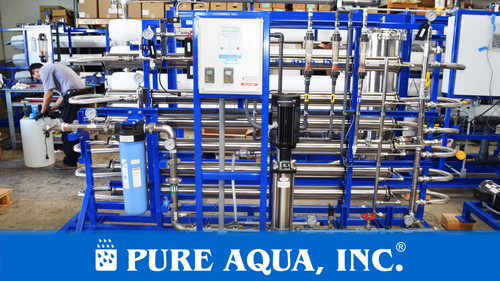Application: Salinity Reduction
This is model SW-16K-1480 from our SWI Series.
- SWI Series
- Pre and Post Treatments
- Prechlorination
- Dechlorination
- Antiscalant Chemical Dosing Systems
- 16,000 GPD
- Maximum 42,000 PPM Feed Water
[custom-specifications]
Water Challenges: There has never been a case where seawater has been an acceptable source of drinking water for human beings. Regardless of how thirsty a person might be, consuming seawater will only make you thirstier. This is due to the high amounts of salt in the ocean, which affects the body once ingested by forcing it to urinate more water than your consumed to eliminate the excess salt. This leaves a person even thirstier and eventually to the point of dehydration, and then death. For this reason, seawater must be thoroughly gone through a purification process in order to greatly reduce the elevated levels of salt in the water and produce fresh, potable water that is safe to consume. Seawater reverse osmosis systems have become the preferred method of choice to treat seawater, and a recent application in Ecuador has required the shipping of one from our industrial plant for the purposes of reducing salinity.
[/custom-specifications]
[custom-features]
Applied Solution: Pure Aqua manufactured and supplied Sea Water Reverse Osmosis system complete with pre and post treatment to a major company in Ecuador. The system was designed to produce 16,000 GPD.
[/custom-features]
[custom-usage]
From its initial start-up, the SWRO system has been running properly with minimal trouble-shooting. Industrial seawater reverse osmosis systems are mainly designed for the removal of enormous amounts of salt and other impurities from highly inconsumable water sources like the sea. These systems take use of a popular process known as “reverse osmosis” to help in seawater purification. The job of reverse osmosis is to defeat the osmotic pressure of a natural process called “osmosis”. Osmosis naturally pushes salt through a very fine membrane from an area with low saline concentration to an area with high saline concentration. The goal of osmosis is to gain an equal amount of saline concentration on both sides. To stop this natural process, reverse osmosis pushes osmosis in the opposite direction by using a high pressure pump that adds extreme pressure to the highly concentrated saline side of the membrane. The pressure pushes only water molecules through the small pores of the membrane while rejecting salts and other impurities from flowing through. Clean, potable water successfully comes out on the permeate side while salt and the other impurities are dumped into a drain from the concentrate side.
[/custom-usage]
SWRO System 16,000 GPD - Ecuador - Case Study [/custom-documents]
-
Good Water Treatment System
For my NSF certification this product has been doing good. No rejection for water quality.
 ENGLISH arrow_drop_down
ENGLISH arrow_drop_down
 ESPAÑOL
ESPAÑOL ???????
??????? PORTUGUÉS
PORTUGUÉS FRANÇAIS
FRANÇAIS















